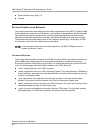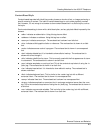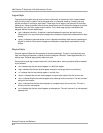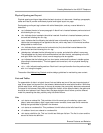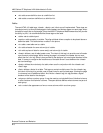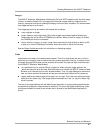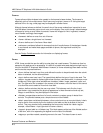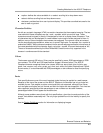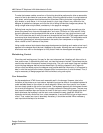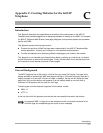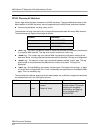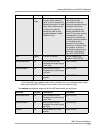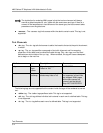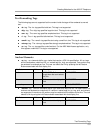
4600 Series IP Telephone LAN Administrator’s Guide
Design Guidelines
B-10
Cookies 5
Cookies can be a useful feature in maintaining the state of a user when interacting with a web site.
HTTP provides no state information, such as when or how often a user has visited a site. Cookies
allow web sites to track this information by storing a simple set of values on the browser for the
current session. Normally, browsers also provide the ability to save cookies to disk, so this
information may be retained between sessions. However, the 4630 IP Telephone browser has no
such ability to save any data between sessions. Cookies do behave well within the realm of the
current session, and may be employed if desired. The 4630 IP Telephone has a maximum of
8Kilobytes of data available for cookie storage.
Design Guidelines 5
This section presents guidelines for developing a good model that effectively presents web pages
to be viewed on the 4630 IP Telephone Browser. The biggest challenge in designing pages for this
browser is the limited amount of space available for viewing the pages. The 4630 IP Telephone
screen is a ¼ VGA display. Part of that screen is lost to the browser by the main controls of the
4630 IP Telephone. Thus, page layout must be done effectively and efficiently so as to avoid
causing more space to be lost through additional screen controls such as scrollbars. Font sizing
will make or break the usability of a page. A balance must be found between fitting as much text as
is possible, and allowing users to read the text without straining their eyes.
Fixed-Width Objects 5
One of the primary functions of a web browser is to present text, wrapped at the right (or left when
dealing with internationalization) border of the browser window. The browser always attempts to
avoid adding a horizontal scrollbar. However, if fixed-width objects, such as tables and pre-
formatted (<pre> tags) text are used, the browser makes wrapping a secondary priority to
presenting the data exactly as the HTML dictated.
Web browsers do not resize themselves larger when scrollbars are added. Thus, if there are more
lines of text than can fit in the height of the browser window, a vertical scrollbar is added. This now
takes up some of the width of the browser, and less text is displayed on a single line. If text is wider
than the width of the browser, a horizontal scrollbar is added. This now takes up some of the height
of the browser, and fewer lines of text are displayed.
Given the small size of the browser, it is highly desirable to avoid causing scrollbars to appear.
Unless the amount of text shown in a page is kept to a bare minimum, it is unlikely that a vertical
scrollbar will be avoided. However, avoiding fixed-width objects, or ensuring that the size of fixed-
width is kept small, will gain some viewable space on the browser.
In general, if scrolling is a requirement, vertical scrolling is better perceived by users than
horizontal scrolling.



